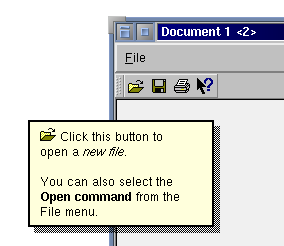| Home | All Classes | Main Classes | Annotated | Grouped Classes | Functions |
The TQWhatsThis class provides a simple description of any widget, i.e. answering the question "What's this?". More...
#include <ntqwhatsthis.h>
Inherits TQt.
"What's this?" help is part of an application's online help system that provides users with information about functionality, usage, background etc., in various levels of detail from short tool tips to full text browsing help windows.
TQWhatsThis provides a single window with an explanatory text that pops up when the user asks "What's this?". The default way to do this is to focus the relevant widget and press Shift+F1. The help text appears immediately; it goes away as soon as the user does something else.
(Note that if there is an accelerator for Shift+F1, this mechanism will not work.)
To add "What's this?" text to a widget you simply call TQWhatsThis::add() for the widget. For example, to assign text to a menu item, call TQMenuData::setWhatsThis(); for a global accelerator key, call TQAccel::setWhatsThis() and If you're using actions, use TQAction::setWhatsThis().
The text can be either rich text or plain text. If you specify a rich text formatted string, it will be rendered using the default stylesheet. This makes it possible to embed images. See TQStyleSheet::defaultSheet() for details.
const char * fileOpenText = "<p><img source=\"fileopen\"> "
"Click this button to open a <em>new file</em>. <br>"
"You can also select the <b>Open</b> command "
"from the <b>File</b> menu.</p>";
TQMimeSourceFactory::defaultFactory()->setPixmap( "document-open",
fileOpenAction->iconSet().pixmap() );
fileOpenAction->setWhatsThis( fileOpenText );
An alternative way to enter "What's this?" mode is to use the ready-made tool bar tool button from TQWhatsThis::whatsThisButton(). By invoking this context help button (in the picture below the first one from the right) the user switches into "What's this?" mode. If they now click on a widget the appropriate help text is shown. The mode is left when help is given or when the user presses Esc.

If you are using TQMainWindow you can also use the TQMainWindow::whatsThis() slot to invoke the mode from a menu item.
For more control you can create a dedicated TQWhatsThis object for a special widget. By subclassing and reimplementing TQWhatsThis::text() it is possible to have different help texts, depending on the position of the mouse click. By reimplementing TQWhatsThis::clicked() it is possible to have hyperlinks inside the help texts.
If you wish to control the "What's this?" behavior of a widget manually see TQWidget::customWhatsThis().
The What's This object can be removed using TQWhatsThis::remove(), although this is rarely necessary because it is automatically removed when the widget is destroyed.
See also TQToolTip and Help System.
When the widget is queried by the user the text() function of this TQWhatsThis will be called to provide the appropriate text, rather than using the text assigned by add().
The text is destroyed if the widget is later destroyed, so it need not be explicitly removed.
See also remove().
Examples: application/application.cpp, helpsystem/mainwindow.cpp, and mdi/application.cpp.
This virtual function is called when the user clicks inside the "What's this?" window. href is the link the user clicked on, or TQString::null if there was no link.
If the function returns TRUE (the default), the "What's this?" window is closed, otherwise it remains visible.
The default implementation ignores href and returns TRUE.
If widget w is not 0 and has its own dedicated TQWhatsThis object, this object will receive clicked() messages when the user clicks on hyperlinks inside the help text.
See also TQWhatsThis::clicked().
TQt will install a special cursor and take over mouse input until the user clicks somewhere. It then shows any help available and ends "What's this?" mode. Finally, TQt removes the special cursor and help window and then restores ordinary event processing, at which point the left mouse button is no longer pressed.
The user can also use the Esc key to leave "What's this?" mode.
See also inWhatsThisMode() and leaveWhatsThisMode().
See also enterWhatsThisMode() and leaveWhatsThisMode().
This function is used internally by widgets that support TQWidget::customWhatsThis(); applications do not usually call it. An example of such a widget is TQPopupMenu: menus still work normally in "What's this?" mode but also provide help texts for individual menu items.
If text is not TQString::null, a "What's this?" help window is displayed at the global screen position pos. If widget w is not 0 and has its own dedicated TQWhatsThis object, this object will receive clicked() messages when the user clicks on hyperlinks inside the help text.
See also inWhatsThisMode(), enterWhatsThisMode(), and TQWhatsThis::clicked().
See also add().
The default implementation returns TQString::null.
If includeParents is TRUE, parent widgets are taken into consideration as well when looking for what's this help text.
See also add().
(void) TQWhatsThis::whatsThisButton( my_help_tool_bar );
Example: helpsystem/mainwindow.cpp.
This file is part of the TQt toolkit. Copyright © 1995-2007 Trolltech. All Rights Reserved.
| Copyright © 2007 Trolltech | Trademarks | TQt 3.3.8
|